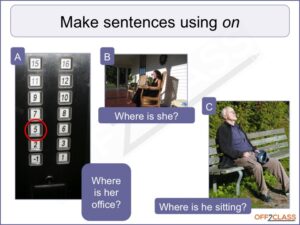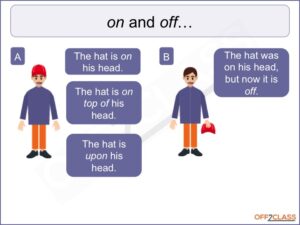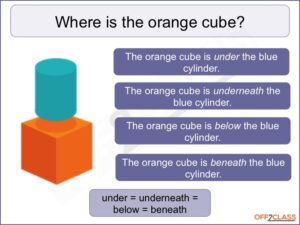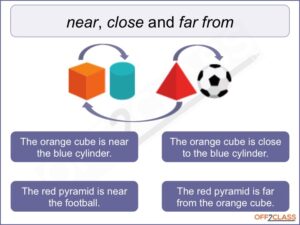{{ post.title }}
{{ post.excerpt }}
Read full story…and we’re happy to announce that they are ready, for you to teach! You can find our 8 lessons covering prepositions of place and location filed under the Prepositions Category on our Teacher tab. If you don’t yet have an account for Off2Class, set one up on our Home page. Here’s a brief summary of what you can expect to find in our prepositions of place and location series:
P2.1 – Of-Place-At-In-On (P2.1 to P2.3)
We start our series with the most common prepositions of place and location (and sometimes the trickiest for ESL learners) – in, at and on. Remember, we use in to show location inside a continent, country, city and a room, a part of a room and other defined areas (the tree is in the backyard). We use at to describe places where people do things (I’m at work). We use on to describe streets, floors/levels, street addresses and vehicles. Our first three introductory lessons provide ample exercises for your students to naturally discover the uses of these core prepositions of place and location; and see how often they are used in everyday speech:


P2.4 – Of-Place-Above-Below-On-Off-Between-Among Against-InFront-Behind – (P2.4 to P2.6)
In the next lessons in our series we explore a series of more advanced prepositions of place and location; used to describe place and location in reference to other objects/nouns. We recommend tackling these lessons once your students are comfortable using the more basic prepositions of place and location: at/on/in. Because place and location can be difficult concepts, we introduce each new preposition by using a very basic diagram, that relates the location of one item, compared to another. We’ve found that this practice works quite well with our own students. Here are some examples for the prepositions on, off, under/underneath/below/beneath:


P2.7 – Of-Place-In-Inside-Within-OutOf-OutsideOf-Near-Far-Beyond (P2.7 – P2.8)
In our final two lessons we cover the most advanced prepositions used to express place and location in relation to other objects/nouns. Some of these prepositions can take on a more subjective reference point (e.g. Madrid is near Paris when referring to flying, but far from Paris when referring to driving). To understand these nuances, the ESL student must be at a stage where they can understand context in a given example or sentence. For these reasons, we recommend holding off on these last lessons until your students are very comfortable with describing place and location. Again, we introduce each preposition of place and location by using very simplified graphical examples such as these:


8 Comments
Suparna Das says:
June 21, 2016 at 2:10 pm
Teaching preposirion to children and adults would be more effective with real life situation. For eg. young children can understand better if the techer would take a piece of chalk and throw it in various directions each time calling out the appropriate name of the preposition will enable proper learning.
For adults let it be a group activity where the teacher too is a participant. Class mingles here would be helpful with the aid of video camera. Later replay would help to remember better with an exercise of personal grooming taking place simultaneously.
Kris Jagasia says:
June 21, 2016 at 2:42 pm
Hi Suparna,
That sounds great for a classroom setting. Any recommendations for one-2-one teachers or online teachers?!
Ian Paul says:
June 22, 2016 at 3:33 am
I teach online, both groups and one 2 one classes, and a box with a ball still works online. I ask students to get a small box and a tennis ball or similar sized ball for the next lesson. This is so I can ‘see’ that they have got the idea. – the ball and box can work well even up to complex prepositional phrases like “Immediately adjacent to the South Western corner”, etc. These slides look good too. I’m particularly in need of them with a large group of Filippino nurses I teach, the Philippines seems to use a localised set of prepositions neither British US, or Australian model appears to be in use. They are losing marks at IELTS tests because of it.
Ian (York, UK)
Kris Jagasia says:
June 22, 2016 at 5:24 pm
Cheers Ian, that’s a really cool concept! Yes it’s pretty much impossible to get a high level IETLTS band in speaking and writing if you don’t have your prepositions down!
Gayleen says:
June 21, 2016 at 3:03 pm
I had a brilliant professor of German.He merely stood on a chair at the beginning of lecture and proclaimed. “Uber, Unter, etc” Under, over, beside, below, next to etc and I have tried it may times with school students,They understand right away. (You can make it a “Simon Says'” game if they are young)
The professor next showed us a picture of a river. We then drew it and as he called out the new words we wrote down “At, near, far from, etc” We never had any further problem identifying and remembering prepositions/ prepositional phrases.
Kris Jagasia says:
June 21, 2016 at 3:20 pm
Great idea Gayleen!
Clark says:
November 9, 2021 at 6:26 am
I was teaching ESL to kindergarten kids at a training center in China. I had several Chinese teachers to assist me.
I created an obstacle course out of chairs and tables and assigned a preposition to each one: over, under, around (as in circumnavigate), between. A teacher stood at each obstacle and the kids ran the course and had to say and do each preposition at each obstacle.
Regan says:
November 9, 2021 at 10:02 pm
This is an incredible idea, thanks for sharing Clark. It is amazing to see how you can incorporate a variety of activities to complement Off2Class lessons!